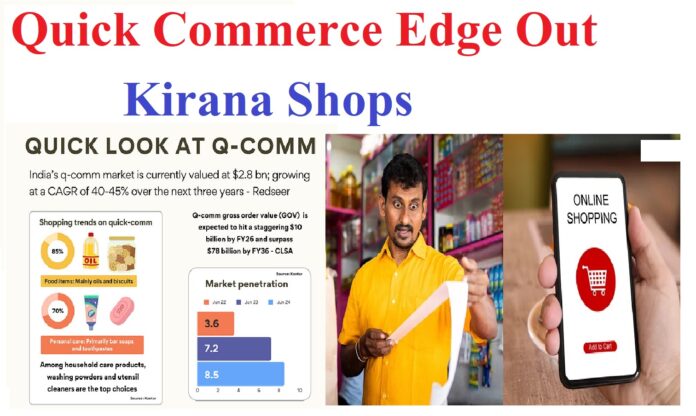(NTI): India’s retail sector, particularly its food and grocery market, has long been dominated by kirana stores—traditional, family-owned shops. Today, around 1.3 crore kirana shops represent over 95% of India’s $600 billion food and grocery sector. However, the rapid rise of quick commerce (q-comm) platforms—promising swift delivery times, efficient last-mile logistics, and a wide array of products—has raised questions about the future of these neighborhood stores.
A Growing Threat?
Quick commerce, a barely 3-4 years sector, is beginning to reshape how some Indians shop. According to Kantar, the penetration of q-comm has more than doubled over three years, with the Moving Annual Total (MAT) penetration jumping from 3.6% in June 2022 to 8.5% by June 2024. The MAT metric reflects total sales or penetration over a rolling 12-month period, highlighting the speed at which q-comm has grown in the retail space.
The traditional retail model sees distributors purchasing stock from companies and supplying it to retailers, who then sell to consumers. Q-comm, on the other hand, follows a direct business-to-consumer (B2C) approach, bypassing distributors and directly delivering goods from companies to consumers.
This shift in the supply chain has led to concerns, especially among distributors. However, some industry experts argue that q-comm is not replacing traditional retailers but rather expanding market opportunities.
Complementary or Competitive?
Krishnarao Buddha, senior category head at Parle Products, dismisses the concerns raised by distributors, noting that q-comm isn’t pulling sales away from kiranas but is instead adding new touchpoints for brands. “For any traditional FMCG brand, modern trade accounts for 10% of sales, e-commerce for 2-3%, and quick commerce for roughly 1.5%. Q-comm is creating new opportunities for brands, not merely taking away from existing ones,” Buddha states.
For emerging brands like Gatih Foods, q-comm has been a game changer. Pankaj Mishra, founder of Gatih Foods, mentions that despite geographical challenges, q-comm contributes approximately 30% of their revenue, showcasing its potential for newer brands.
However, Buddha points out that distributors had similar fears when modern retail formats like Reliance Retail and D-Mart emerged. Yet, they adapted to those changes, and now, he suggests they must do the same with q-comm.
Kiranas Aren’t Going Anywhere, Yet
Vani Gupta Dandia, who has worked with FMCG giants like PepsiCo and Unilever, warns against generalizing India’s retail landscape. She believes that the idea that “kiranas will die” is too simplistic given India’s diverse market. She emphasizes that q-comm cannot replicate the personal touch that local stores provide. From the joy of browsing products in person to the convenience of credit, kirana stores offer experiences that q-comm platforms struggle to match.
Moreover, delivery fees, handling charges, and the challenge of reaching India’s most remote areas remain hurdles for q-comm. Currently, Zomato-backed Blinkit operates in 39 cities, Zepto in around 10-11 cities, and Swiggy’s Instamart in 25 cities. These platforms are largely metro-centric, and while they are expanding, they have yet to make significant inroads into rural areas, where 65% of India’s population resides.
A Potential Threat to Established Brands?
Traditional companies like Hindustan Unilever, Marico, PepsiCo, and Dabur have long relied on their extensive distribution networks to dominate the market. But as q-comm expands, it may challenge these established brands, especially if the platforms reach remote areas and offer a viable alternative to the traditional retail supply chain.
Jay Sachdev, marketing manager at Balaji Wafers, notes that while quick commerce has evolved, it still accounts for only 1% of sales compared to the 97% generated from general trade. He suggests that over the next decade, q-comm may grow to capture 5-6% of the market, but it is unlikely to replace kirana shops entirely.
One key advantage of general trade, according to Sachdev, lies in the affordability of smaller, low-cost items like packets priced at Rs 5 or Rs 10, which are often unavailable on q-comm platforms. Kirana stores, therefore, remain indispensable for selling these fast-moving, low-cost goods.
The Road Ahead
As q-comm continues to gain ground, it is clear that the retail landscape in India is evolving. Manoj Menon, commercial director at Kantar Worldpanel, notes that nearly 85% of q-comm shoppers are purchasing food items, with cooking ingredients and biscuits among the most popular products. Additionally, 7 out of 10 shoppers buy personal care items like soaps and toothpaste, while household care products such as washing powders and utensil cleaners are also frequently purchased through q-comm platforms.
However, Menon acknowledges that while the popularity of q-comm is growing, particularly in metro areas, its penetration in rural markets remains low. Kirana shops are still vital to India’s retail ecosystem, and for now, they remain irreplaceable.
As more households shift from e-commerce to quick commerce, the channel’s penetration is expected to close the gap with traditional e-commerce in the coming years. But whether q-comm can entirely edge out kirana shops remains an open question. In a country as vast and diverse as India, it seems that both modern and traditional retail models may coexist for the foreseeable future.


